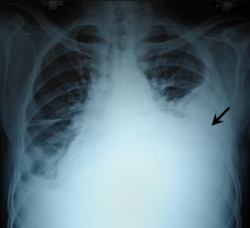Hemothorax

Editor-In-Chief: Prab R Tumpati, MD
Obesity, Sleep & Internal medicine
Founder, WikiMD Wellnesspedia &
W8MD medical weight loss NYC and sleep center NYC
| Hemothorax | |
|---|---|

| |
| Synonyms | N/A |
| Pronounce | N/A |
| Specialty | N/A |
| Symptoms | Chest pain, dyspnea, tachycardia, hypotension |
| Complications | Respiratory failure, shock, infection |
| Onset | Sudden |
| Duration | Variable |
| Types | N/A |
| Causes | Trauma, surgery, cancer, blood clotting disorders |
| Risks | Rib fracture, anticoagulation therapy |
| Diagnosis | Chest X-ray, CT scan, ultrasound |
| Differential diagnosis | Pneumothorax, pleural effusion, pulmonary embolism |
| Prevention | N/A |
| Treatment | Chest tube, thoracotomy, blood transfusion |
| Medication | N/A |
| Prognosis | Depends on cause and treatment |
| Frequency | Common in trauma cases |
| Deaths | N/A |
Hemothorax[edit]

Hemothorax is a medical condition characterized by the accumulation of blood in the pleural cavity—the space between the lungs and the chest wall. This condition is a type of Pleural effusion and is considered a medical emergency. Hemothorax can compromise breathing and, if left untreated, can lead to serious health complications, including respiratory failure and shock.
Definition and Pathophysiology[edit]
Hemothorax occurs when blood collects in the pleural space, which normally contains a small amount of fluid to facilitate lung movement during breathing. The presence of blood in this space can be due to trauma, medical procedures, or pathological processes that disrupt the blood vessels within the chest cavity.
Causes[edit]
The most common causes of hemothorax include:
- Chest trauma
- Such as from a motor vehicle accident, fall, or penetrating injury, which can damage the blood vessels of the lung or chest wall.
- Surgery
- Complications from chest or heart surgery may lead to a hemothorax.
- Pulmonary embolism
- A pulmonary embolism with infarction can lead to bleeding into the pleural space.
- Malignancy
- Tumors in the chest can erode into blood vessels, causing a hemothorax.
- Coagulopathy
- Disorders of blood clotting can predispose an individual to bleeding, including into the pleural cavity.
Symptoms[edit]
Symptoms of a hemothorax can vary depending on the volume of blood accumulated and may include:
- Chest pain
- Shortness of breath
- Low blood pressure
- Rapid heartbeat
- Bluish skin due to lack of oxygen
Diagnosis[edit]
Diagnosis of hemothorax generally includes:
- Physical examination, which may reveal reduced breath sounds on the affected side
- Chest X-rays showing a fluid level in the pleural space
- Ultrasound of the chest, which can detect fluid accumulation
- CT scan of the chest for a more detailed assessment
- Thoracentesis, where a needle is inserted into the pleural space to obtain a sample of the fluid for analysis
Treatment[edit]
Treatment of hemothorax typically involves:
- Immediate stabilization of the patient's airway, breathing, and circulation
- Chest tube insertion to drain the blood from the pleural space
- Surgery in cases of ongoing bleeding or large, clotted hemothorax
- Treatment of the underlying cause of the hemothorax
- Blood transfusions if a significant amount of blood is lost
Prognosis and Complications[edit]
The prognosis for individuals with hemothorax depends on the cause and the promptness of treatment. Potential complications include:
- Infection leading to Empyema
- Fibrothorax due to scarring and entrapped lung
- Pneumonia
Preventive Measures[edit]
Preventive measures for hemothorax focus on minimizing chest trauma and managing underlying health conditions that could contribute to bleeding.
See Also[edit]
References[edit]
- Clinical Aspects of Hemothorax. Thoracic Medicine, 2023.
- Emergency Management of Hemothorax. Trauma Care, 2023.
External Links[edit]
Ad. Transform your life with W8MD's Budget GLP-1 injections from $75


W8MD offers a medical weight loss program to lose weight in Philadelphia. Our physician-supervised medical weight loss provides:
- Weight loss injections in NYC (generic and brand names):
- Zepbound / Mounjaro, Wegovy / Ozempic, Saxenda
- Most insurances accepted or discounted self-pay rates. We will obtain insurance prior authorizations if needed.
- Generic GLP1 weight loss injections from $75 for the starting dose.
- Also offer prescription weight loss medications including Phentermine, Qsymia, Diethylpropion, Contrave etc.
NYC weight loss doctor appointmentsNYC weight loss doctor appointments
Start your NYC weight loss journey today at our NYC medical weight loss and Philadelphia medical weight loss clinics.
- Call 718-946-5500 to lose weight in NYC or for medical weight loss in Philadelphia 215-676-2334.
- Tags:NYC medical weight loss, Philadelphia lose weight Zepbound NYC, Budget GLP1 weight loss injections, Wegovy Philadelphia, Wegovy NYC, Philadelphia medical weight loss, Brookly weight loss and Wegovy NYC
|
WikiMD's Wellness Encyclopedia |
| Let Food Be Thy Medicine Medicine Thy Food - Hippocrates |
Medical Disclaimer: WikiMD is not a substitute for professional medical advice. The information on WikiMD is provided as an information resource only, may be incorrect, outdated or misleading, and is not to be used or relied on for any diagnostic or treatment purposes. Please consult your health care provider before making any healthcare decisions or for guidance about a specific medical condition. WikiMD expressly disclaims responsibility, and shall have no liability, for any damages, loss, injury, or liability whatsoever suffered as a result of your reliance on the information contained in this site. By visiting this site you agree to the foregoing terms and conditions, which may from time to time be changed or supplemented by WikiMD. If you do not agree to the foregoing terms and conditions, you should not enter or use this site. See full disclaimer.
Credits:Most images are courtesy of Wikimedia commons, and templates, categories Wikipedia, licensed under CC BY SA or similar.
Translate this page: - East Asian
中文,
日本,
한국어,
South Asian
हिन्दी,
தமிழ்,
తెలుగు,
Urdu,
ಕನ್ನಡ,
Southeast Asian
Indonesian,
Vietnamese,
Thai,
မြန်မာဘာသာ,
বাংলা
European
español,
Deutsch,
français,
Greek,
português do Brasil,
polski,
română,
русский,
Nederlands,
norsk,
svenska,
suomi,
Italian
Middle Eastern & African
عربى,
Turkish,
Persian,
Hebrew,
Afrikaans,
isiZulu,
Kiswahili,
Other
Bulgarian,
Hungarian,
Czech,
Swedish,
മലയാളം,
मराठी,
ਪੰਜਾਬੀ,
ગુજરાતી,
Portuguese,
Ukrainian


